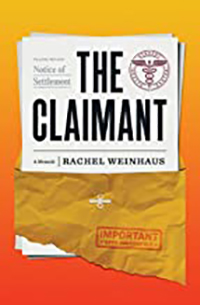The Claimant by Rachel Weinhaus; St. Louis, Missouri: G&B Media © 2022; ISBN 9798986-700304; 188 pages, $14.99. Publication date: November 15, 2022

 SAN DIEGO – Two acts of sexual violation lay suppressed in Rachel Weinhaus’s memory. The more recent instance had occurred nearly two decades earlier when she was a student at the University of Southern California. She had made an appointment with gynecologist Dr. George Tyndall to renew her prescription for birth control pills. He examined her breasts, keeping one finger on her nipple, and gave her a pelvic examination. He also commented about the freckles all over her body and speculated about the excitement with which she and her then out-of-town boyfriend would have reunion sex. Rachel felt humiliated but said nothing to anyone. He was the doctor, an authority figure; perhaps what he did was within bounds.
SAN DIEGO – Two acts of sexual violation lay suppressed in Rachel Weinhaus’s memory. The more recent instance had occurred nearly two decades earlier when she was a student at the University of Southern California. She had made an appointment with gynecologist Dr. George Tyndall to renew her prescription for birth control pills. He examined her breasts, keeping one finger on her nipple, and gave her a pelvic examination. He also commented about the freckles all over her body and speculated about the excitement with which she and her then out-of-town boyfriend would have reunion sex. Rachel felt humiliated but said nothing to anyone. He was the doctor, an authority figure; perhaps what he did was within bounds.
Rachel’s name was extracted from the records of USC’s Student Health Service. An official letter informed her that a lawsuit had been brought successfully against Tyndall, and that she was entitled to damages depending on the extent of her injuries. She was required to fill out an explicit questionnaire. One question at the end of the questionnaire brought back another suppressed memory: “Have you had any experience prior to your visit(s) with Dr. Tyndall that you felt constituted inappropriate sexual behavior or abuse? If so, please describe.”
The question unlocked a long ago, unwanted memory. When she was just five years old, a teenage boy who was a neighbor, took her to the woods, and inserted his finger into her vagina. She never told her parents, nor anyone else, about what had happened. But it had changed her. No longer was outside her favorite place to play as a child; she preferred the basement away from threats. Not long after the abuse had occurred, she threw a fit when her mother wanted her to wear a dress for a special occasion. She wanted to stay in pants, less vulnerable to unwanted sexual attention. At five, of course, she could not explain that, and much to her later resentment, her mother, a therapist, did not understand her change of behavior, nor did she give her the attention that she gave to her clients. Rachel bottled up feelings of emotional abandonment.
Rachel first tossed out the claim form without looking at it, but her husband retrieved it from the trash. At first, she felt guilty even filling it out. What were these incidents after all, she thought mistakenly. They were no big deal. But, of course, they were; neither little girl Rachel nor college woman Rachel had been raped, but both had been physically violated, with resultant impacts upon her mental health.
This memoir alternates between a documentary history, including the wording of the intake forms, and stream of consciousness where one suppressed memory gives way to another. Her self-doubt, guilt, and self-recrimination are skillfully related in this searing memoir. Intellectually she knew that she was not at fault in either situation – how could she be – but her sense of shame sometimes overwhelmed her.
This is not an easy book to read, and I am not sure for what age levels it would be appropriate, but I believe it is an important contribution that will help not only victims of sexual abuse but also will aid their friends and family in understanding the torment that afflicts victims, even those who pretend “it’s no big deal.”
*
Donald H. Harrison is editor emeritus of San Diego Jewish World. He may be contacted via donald.harrison@sdjewishworld.com